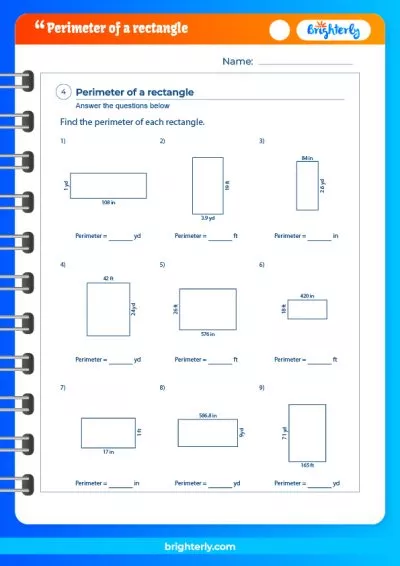Perimeter – Definition, Regular & Irregular Shapes
Updated on January 14, 2024
Welcome to the exciting world of perimeter at Brighterly! As a crucial mathematical concept, the perimeter helps us measure the distance around a two-dimensional shape or figure, and it’s the sum of the lengths of all the sides or edges of a polygon. In our everyday lives, we use the perimeter in various ways, such as determining the amount of fencing required to enclose a playground, figuring out the dimensions of a room, or even measuring the outline of an art project.
At Brighterly, we believe that understanding the perimeter can be a captivating and engaging learning experience for children. By exploring different shapes, their perimeters, and discovering how they relate to real-life scenarios, young learners can foster their curiosity and develop a passion for mathematics. In this comprehensive article, we’ll cover everything there is to know about perimeters – from the basics to more advanced concepts – and learn how to find them, explore the differences between perimeter and area, and much more!
What is Perimeter?
The perimeter is an important mathematical concept that helps us measure the distance around a two-dimensional shape or figure. It’s the total length of all the sides or edges of a polygon. In everyday life, we use the perimeter to calculate the amount of fencing needed to enclose a garden or the length of a running track. Understanding the perimeter can also help us with various problem-solving tasks and real-life applications.
For young learners, grasping the concept of perimeter can be a fun and engaging process. Exploring different shapes and their perimeters can foster their curiosity, and ultimately, a love for mathematics. In this article, we’ll dive into the basics of perimeters, learn how to find them, and explore the difference between perimeters and another important concept, area.
How to Find Perimeter?
Finding the perimeter of a shape is relatively simple. For most polygons, you can find the perimeter by adding the lengths of all the sides together. Let’s look at a few examples:
- Square: A square has four equal sides. To find the perimeter, simply multiply the length of one side by 4.
- Rectangle: A rectangle has two pairs of equal sides. To find the perimeter, add the lengths of two adjacent sides and multiply the sum by 2.
- Triangle: For a triangle, just add the lengths of all three sides.
- Regular Polygon: A regular polygon has equal sides and angles. To find the perimeter, multiply the length of one side by the total number of sides.
For shapes with curved edges, like circles, we use a different formula. The perimeter of a circle is called the circumference, and we’ll discuss that in the next section.
Perimeter Formula
The perimeter formula varies depending on the shape in question. Here are some common formulas for calculating the perimeter of various shapes:
- Square: P = 4 × s (where P is the perimeter and s is the length of one side)
- Rectangle: P = 2 × (l + w) (where l is the length and w is the width)
- Triangle: P = a + b + c (where a, b, and c are the lengths of the triangle’s sides)
- Regular Polygon: P = n × s (where n is the number of sides and s is the length of one side)
- Circle (Circumference): C = 2 × π × r (where π is approximately 3.14159 and r is the radius of the circle)
Difference Between Perimeter and Area
Perimeter and area are both important concepts in geometry, but they measure different aspects of a shape. The perimeter measures the total distance around the shape, while the area measures the amount of space enclosed by the shape. They’re both useful for different purposes, such as calculating the amount of material needed for a project or determining the space available for a particular activity.
To clarify the difference between these two concepts, think of perimeter as the length of a fence enclosing a yard, while area represents the amount of space the yard covers.
Solved Examples On Perimeter
Here are some solved examples to help you understand how to find the perimeter of various shapes:
- Square: Side length = 6 cm, P = 4 × 6 = 24 cm
- Rectangle: Length = 5 cm, Width = 3 cm, P = 2 × (5 + 3) = 16 cm
- Triangle: Side A = 3 cm, Side B = 4 cm, Side C = 5 cm, P = 3 + 4 + 5 = 12 cm
- Regular Pentagon: Number of sides = 5, Side length = 4 cm, P = 5 × 4 = 20 cm
- Circle: Radius = 7 cm, C = 2 × π × 7 ≈ 43.98 cm
Looking for more math worksheets for your kids? Visit the School of Math for Kids by Brighterly! We have a wide range of materials that will help your kids hone their skills and keep them interested in the subject.
Practice Problems On Perimeter
Now it’s time to practice finding the perimeter of various shapes! Try solving these problems on your own or with a friend:
- Find the perimeter of a square with a side length of 10 cm.
- Find the perimeter of a rectangle with a length of 8 cm and a width of 5 cm.
- Find the perimeter of a triangle with side lengths of 6 cm, 8 cm, and 10 cm.
- Find the perimeter of a regular hexagon with a side length of 6 cm.
- Find the circumference of a circle with a radius of 5 cm.
Conclusion
Understanding the concept of perimeter is vital in mathematics and plays a significant role in our daily lives. From calculating the amount of fencing needed to enclose a garden to determining the dimensions of a room, perimeters are everywhere! At Brighterly, we believe that helping young learners grasp the difference between perimeter and area, master the techniques for finding the perimeter of various shapes, and hone their problem-solving skills is the key to building a strong foundation in geometry.
Our approach at Brighterly is to make learning mathematics a fun, engaging, and interactive experience for children. By exploring the world of perimeters through hands-on activities, practical examples, and creative problem-solving tasks, we aim to nurture a love for mathematics and inspire young minds to think beyond the ordinary.
Frequently Asked Questions On Perimeter
What is the perimeter of an irregular polygon?
To find the perimeter of an irregular polygon, simply add up the lengths of all its sides.
How do I find the perimeter of a shape with missing side lengths?
You can use the given information, such as angles or the lengths of other sides, to determine the missing side lengths. Once you have found all the side lengths, you can calculate the perimeter using the appropriate formula.
Does the perimeter of a shape change when it is resized?
Yes, the perimeter of a shape changes when it is resized. When a shape is scaled up or down, its side lengths increase or decrease proportionately, which affects the perimeter.






